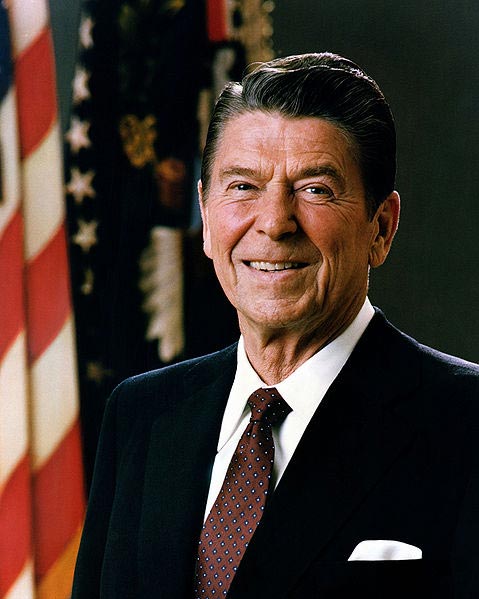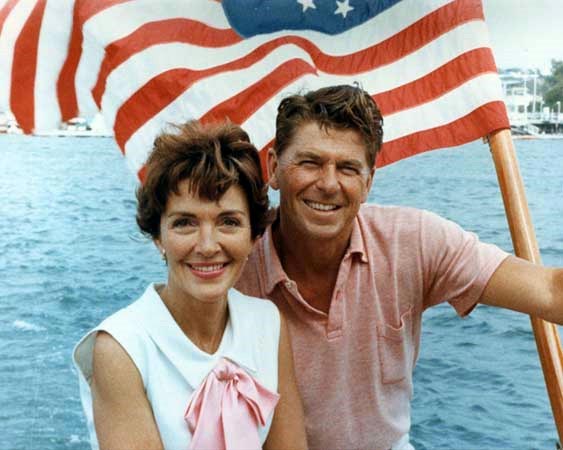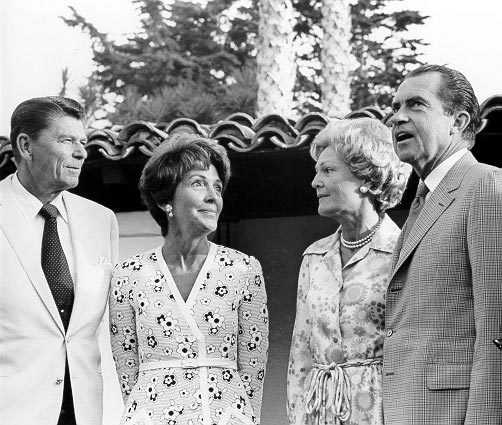| Ronald Reagan | |
|---|---|
 |
|
| 40th United States President « Previous Next » |
|
| In office | Jan. 20, 1981 – Jan. 20, 1989 |
| V. President | George H. W. Bush |
| Political Party | Republican |
| Personal Info | |
| Born | Feb. 6, 1911 |
| Died | June 5, 2004 (at age 93) |
| Religion | Baptized Disciples of Christ, but later joined Presbyterian |
| School | Eureka College |
| Profession | Actor |
| Signature | |
| Wife | Jane Wyman(from 1940–1948) Nancy Davis (from 1952–2004) |
| Children | Maureen Reagan Christine Reagan Michael Reagan Patti Davis Ron Reagan |
| U.S. Presidents 36-43 | |
| 36. Lyndon B. Johnson (1963-1969) | |
| 37. Richard Nixon (1969-1974) | |
| 38. Gerald Ford (1974-1977) | |
| 39. Jimmy Carter (1977-1981) | |
| 40. Ronald Reagan (1981-1989) | |
| 41. George H. W. Bush (1989-1993) | |
| 42. Bill Clinton (1993-2001) | |
| 43. George W. Bush (2001-2009) | |
| List of All the Presidents |
Known for the “Reaganomics policies” and the “Reagan Revolution”, the 40th President of the United States of America, Ronald Reagan was one of the greatest statesmen that has graced the influential assembly of the U.S congress.
Early Life
 Born on Feb. 6, 1911, Ronald Wilson Reagan was raised in Tampico, Illinois where he attended Eureka College, taking up Bachelor of Arts in Economics and Sociology. His appearance at a game of the College’s Cubs as an announcer launched his already brightening future in the field of media.
Born on Feb. 6, 1911, Ronald Wilson Reagan was raised in Tampico, Illinois where he attended Eureka College, taking up Bachelor of Arts in Economics and Sociology. His appearance at a game of the College’s Cubs as an announcer launched his already brightening future in the field of media.
On April 1937, Reagan enlisted for the Army Reserve, determined to prove himself as a private for the 322nd cavalry he had his valor recognized when he became the second lieutenant for the Army Reserve Corps of cavalry in 1937. Due to some vision-related difficulty, Reagan was only submitted for limited duty, and after a few years he was again promoted as Captain in July 1942. Along with Reagan’s promotion, he was also assigned to work on duty in New York City. Then he was reassigned again to join his former troops until the end of the World War.
After his years of service Reagan went home and finished his studies, graduating, he moved to Iowa and pursued a career there as a radio broadcaster and right after moved to Los Angeles and became an actor for televisions and films. These talents sustained him even before the call of politics finally succeeded in reaching him.
With his career careening off to the world of Hollywood Ronald Reagan finally met his fated wife, Jane Wyman, during the filming of the “Brother Rat”. In their union the eldest Maureen was born, and then a few years later came Christine. In the process of their marriage Reagan and Jane adopted a baby named Michael. Their three children however, didn’t stop Jane Wyman from filing a divorce in 1948 there was no choice but to concede so after a year the divorce of Reagan and Jane was finalized in 1949.
Right after the sad ending of his ill-fated marriage, Reagan met, wooed and married actress Nancy Reagan, which proved to be his real and everlasting love. In their union, their daughter Patti finally made an entrance to the world and in 1958, their youngest son Ron was born. “Ronnie” and Nancy celebrated for their devotion and untainted affection for each other through the long years ahead.
Reagan’s Life Before Becoming a Politician
 In the 1950’s, long before the call of politics, Reagan signed to work with General Electric and began on the stepping stones that would lead him to the life of a politician. American conservatism was the word those days known for the ideals of a free market economy, low taxes, limited government, and anti-communism. With the slacking on what we could consider his formal job, G.E. finally cut the strings between the company and Ronald Reagan. During these years too, Reagan a known Democrat and an avid supporter of former President Franklin Roosevelt’s principle became a Republican, due to his wife being a Republican and also of his admission that at the time of G.E. lay-off, the Democrat party abandoned him.
In the 1950’s, long before the call of politics, Reagan signed to work with General Electric and began on the stepping stones that would lead him to the life of a politician. American conservatism was the word those days known for the ideals of a free market economy, low taxes, limited government, and anti-communism. With the slacking on what we could consider his formal job, G.E. finally cut the strings between the company and Ronald Reagan. During these years too, Reagan a known Democrat and an avid supporter of former President Franklin Roosevelt’s principle became a Republican, due to his wife being a Republican and also of his admission that at the time of G.E. lay-off, the Democrat party abandoned him.
When Reagan found his real party in the Republicans, these same people who were impressed by his conduct and charisma nominated him as the Governor of California, emphasizing on his ideals of welfare and clean-up of the student protest infested Berkeley. He was elected and was sworn in January 1967 approving tax hikes and freezing government hiring in the first years of his service. Far from the coveted Presidency, Reagan decided to try out his luck for the highest position in the State merely as a compromise candidate if ever Nixon or Rockefeller failed to achieve the needed delegates for their candidacy. Reagan found himself third in line.
Bloody Thursday and Responding to Protests
As the terms of Reagan’s service progressed, his strength was truly tested with protest movements, a series of incidents now remembered as “Bloody Thursday”. Calling on military troops, Reagan planned on dispersing the crowds of angry protesters that only angered them more, leading to the kidnapping Patti Hearst and of the demands of food supply for the poor. As the protesters became more violent, the ongoing debate for the approval of abortion was already taking place in the Congress. Reagan battled indecision, if he signed the approval there will be more abortions but there will be an assurance for the welfare of the mother, and if he does not it will only lead to more illegal back-room abortions that would put the mother’s life in jeopardy. After the inner debate, Reagan finally signed the abortion approval, launching a howl of angry protests from the populace. Realizing the consequences of his actions, he maintained that he was a pro-life and has owned up to that advocacy throughout his whole political run. And after whole sets of trial and conflict, Reagan was reelected again for his third term as Governor of California in 1974.
After the failure of his attempt for the presidency, Reagan again tried his luck against the President Gerald Ford. Owing to a not so planned strategy, Reagan lost as the confidence of Florida, New Hampshire and his own native town Illinois. However Ford actually prevailed with 1187 votes over Reagan’s 1070. And it was again, another loss for the aspiring president. However, with determination and pride paving his way, Reagan again decided to run for the Presidency in 1980, with President Jimmy Carter as his incumbent Reagan again promoted his fundamentals of low taxes, strong national defense, and less government interference with the public. With this principles strongly at hand, Ronald Wilson Reagan, finally got elected as the 4oth president of the United States of America in 1981.
President Reagan
 During his first term, Reagan was buffeted with national and international conflicts, the end of the Cold war, military expansions, and the U.S. economy. But political expertise and support has always preceded him, and so his greatest contributions in that political arena were slowly revealed.
During his first term, Reagan was buffeted with national and international conflicts, the end of the Cold war, military expansions, and the U.S. economy. But political expertise and support has always preceded him, and so his greatest contributions in that political arena were slowly revealed.
A failed assassination attempt was made on President Reagan on March 30, 1981 by Robert Hinckley Jr., gunshots tore through Reagan’s secretary, an agent, and a police officer. Luckily after a major surgery, Reagan proved himself tough to kill. On April 11, he was released from the hospital and continued his campaign. But why would someone want Reagan killed? Is it because of the escalation of his policies so-called “Reaganomics”? What is Reaganomics?
Reaganomics
 Over Reagan’s first term he implemented the use of his own advocacy called Reaganomics, which is composed of different policies concerning political and economic expenditures of the government. Its major goals were to reduce tax rates, control over the money supply of the state and even the rate of government spending. Its implementation was for America’s economic growth, deregulation and inflation. Inflation considerably decreased during Reagan’s term but unemployment soared and left the U.S. economy wrecked.
Over Reagan’s first term he implemented the use of his own advocacy called Reaganomics, which is composed of different policies concerning political and economic expenditures of the government. Its major goals were to reduce tax rates, control over the money supply of the state and even the rate of government spending. Its implementation was for America’s economic growth, deregulation and inflation. Inflation considerably decreased during Reagan’s term but unemployment soared and left the U.S. economy wrecked.
As Reaganomics continued to progress, word-wide problems began to occur within Reagan’s service. The Cold War that had since plagued the world escalated again, and the rising turmoil that was left in its wake became a major concern of the U.S. President. The Soviet Union was denounced by Reagan as an “evil empire” due to its practice of Communism. The Soviet Union finally agreed to a negotiation with President Reagan, major communications bridged the matters as the Soviet sent Mikhail Gorbachev himself, preventing or at least delaying a universal conflict that might have peaked between the two countries.
Because of their different views, not all the demands were met, and only a partnership for military arsenal concluded the negotiation. For a time, this prevented another explosion between two powerful nations and opening a new kind of rule in the Soviet Union. When the matter with the Soviet was settled, critics announced that Reagan’s foreign policies were aggressive and imperialistic. Some even considered that it was a kind of “warmongering”. For better or worse, it maintained peace for Americans.
Re-election
 As the negotiations ended, a pending reelection was being supported by Reagan’s party. Ronald Reagan once again campaigned for reelection in 1984. In one of his speeches, he declared that it was “morning again in America”, even contributing to an athlete’s foundation. During one of the campaign addresses, presidential candidate Walter Mondale mentioned that Reagan was not himself that day, finding his speech delivery weaker than usual. It was very far below what his supporters knew he could do. They never suspected that the President’s behavior was the onset of an already creeping disease. Supporters became anxious when they saw that Reagan may not get through the election; some thought that a second term as President would be beyond the ailing President’s capabilities. Surprisingly, Reagan won the election and served for his second term in 1985.
As the negotiations ended, a pending reelection was being supported by Reagan’s party. Ronald Reagan once again campaigned for reelection in 1984. In one of his speeches, he declared that it was “morning again in America”, even contributing to an athlete’s foundation. During one of the campaign addresses, presidential candidate Walter Mondale mentioned that Reagan was not himself that day, finding his speech delivery weaker than usual. It was very far below what his supporters knew he could do. They never suspected that the President’s behavior was the onset of an already creeping disease. Supporters became anxious when they saw that Reagan may not get through the election; some thought that a second term as President would be beyond the ailing President’s capabilities. Surprisingly, Reagan won the election and served for his second term in 1985.
An event that marred Reagan’s second term was that of the disintegration of Space Shuttle Challenger, killing all the astronauts aboard and destroying over millions of dollars. Conservative activists also made a show at the White House, but little attention was given to them. Their requests for removal of Chief of Staff Baker were not only met disapproval but also an ironic turnabout when Reagan appointed Baker as Secretary for the United States Treasury. Another event that stirred further disapproval from the public was when the President decided to visit a cemetery and considered the SS members buried there as victims of the holocaust. His staff and supporters strongly disagreed with Reagan.
A bill was signed in Reagan’s second term, which was the “No to Drugs.” His wife, First lady Nancy Reagan made the bill her top priority right after its approval; she built a foundation for the “Just Say No” drug awareness campaign that promoted the use of drugs only for medical necessity rather than for recreational enjoyment that young people tended toward. The bill became a top advocacy for the First lady and has earned the approval of not only the First family’s constituents but also of the general public.
Along with the “No to Drugs bill”, America also gave a hand in various problems across the globe, including the bombing in Libya, the immigration law at the time, and the Iran Contra Affair. One of the most celebrated successes during Reagan’s second term was the end of the Cold War, when the Soviet Union’s Gorbachev decided to sign a peace treaty with the United States. Reagan realized that Gorbachev indeed formed a new kind of diplomacy that would also influence to other Communist countries.
President Ronald Reagan ended his second term and descended from office in 1989, some economists thought that Reagan brought about a new America populated with contented people that do not fear communism. It would be brought about with a new hope the world would not threatened by wars and national conflicts. But as the years went by, critics agreed that Reagan’s “Reaganomics policies” only served as a gilt for the President’s political run and had proved itself to be a failure when it came to the real problems faced by the U.S. economy, some even stated that the policy only buried the U.S. in greater debts. It was mayhap, the envy of some people who considered Reagan’s effort to be worthless, but in time he still proved to be one of the greatest American President that stood before the Congress who presented them what he thought would was right. Ten years after, Ronald Reagan was stricken with Alzheimer’s disease was struck down with pneumonia on June 5, 2004 at the age of 98.